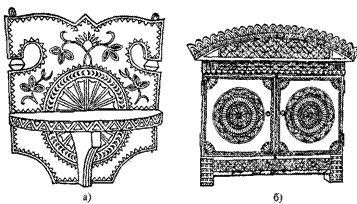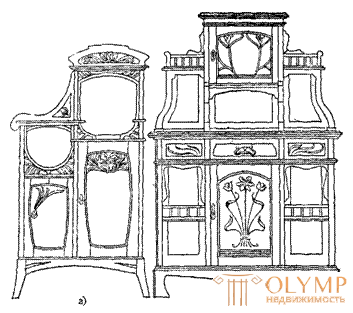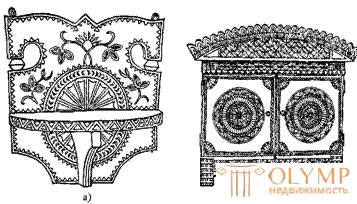
At the end of the XIX century. changing the style of furniture. In the 1970s and 1980s, the furniture of P. Gambs, the owner of one of the oldest furniture workshops in St. Petersburg, was widely spread, which he showed for the first time at the Exhibition of Industrial Products of the Russian Empire (1849). Gambs furniture products are similar in nature to the rococo shapes. Chairs, armchairs and sofas framed along the contour with a wooden rim of a complex profile. The furniture was comfortable. The backs of soft chairs, armchairs, sofas were often quilted.
Gilded bronze, porcelain in the form of embedded medallions, overlays, inlays with floral patterns and pastoral scenes, inlaid with various wood species, bone, mother-of-pearl, non-ferrous metals have become widespread in the decoration of furniture. Introduction to the production of furniture chemical masses, similar in color and pattern to the tortoise plates, allowed to create furniture products under the style of Boole.
In the 1970s and 1980s, “kutana” furniture also found wide distribution, trimmed with frills, draperies, decorative nets of intricate weave with tassels and bombs, a wide multi-tiered fringe descending to the floor, cords, tassels. A necessary addition to the upholstery of upholstered furniture is a decorative upholstery braid of a complex patterned weave, often connected with a rope of various thicknesses.
Headsets of offices and dining rooms were performed either in the style of Renaissance furniture or baroque. Sometimes stylized furniture was supplemented with authentic fragments of carving, studded with preserved colored and gold leathers of the 16th — 17th centuries. spanish, italian and french work.
At the end of the XIX century. there are also furniture products in the pseudo-Russian style, the forms of which contradicted both the functional purpose of the object and the authentic traditions of antique and folk furniture. A typical example of such furniture is a chair with an arc-back and armrests in the form of axes.
Late XIX - early XX century. in Russia is characterized by the emergence of the capitalist economic system, the development of industry, the growth of cities, the emergence of new social ideas and movements. In the second half of the XIX century. The intensive capitalist development of the country led to the emergence of new types of architectural structures that had no analogues in the past: railway stations, covered markets, department stores, office buildings. The most characteristic type of urban building of this time was a multi-family apartment building. V.I. Lenin wrote: “The growth of trade, factories, cities, railways makes a demand for completely different constructions, unlike either in their architecture or in their size in the old buildings of the patriarchal era” (Lenin V.I. Poln. Sobr. cit., vol. 3, pp. 530-531).
At the end of the XIX century. began to use reinforced concrete. The classical order system, which expresses the tectonics of stone rack-and-beam and wall structures, turned out to be incompatible with new constructive solutions, subject to other tectonic principles and proportional to the laws.
In the last decade of the century, the modernist style is beginning to appear more and more actively both in architecture and in the solution of interiors and furniture. In Russia, this trend is characterized by a number of individual signs. A distinctive feature of modernity, as is well known, was its opposition to eclecticism. In Russian architecture, the modern style in its pure form is relatively rare, as a rule, elements of various styles are introduced into it. The architecture of the modernist style is characterized by an appeal to new building and facing materials, the use of metal, ceramics, facing bricks, and large glass surfaces. The masters of modernity sought to more fully match the composition of the structure of its function, taking into account the sanitary and hygienic requirements for architecture.
A great contribution to the development of modern architecture was introduced by F. O. Shekhtel (1859–1926). He owns such facilities as the mansions of Morozova, Ryabushinsky, De rozhinsky, the building of the Yaroslavsky railway station and the building of the Art Theater in Moscow.
The interiors of the mansion of Z. G. Morozova, built in 1893, are designed in the same style with the facades and are subject to the motives of the English Gothic. The single direction of the solution of the whole building was very progressive for that period of development of architecture, when eclecticism reigned and when not only in one building, but often in one room, completely different styles met. Shekhtel widely introduces woodcarving into the interiors of the mansion: carved frames framing windows, doorways and a mirror in the lobby, lancet arches separating the lobby from the avant-hall, high backs of sofas and armchairs have a light openwork of their forms and create a feeling of spaciousness. The beauty of the interiors of the mansion is in harmony of the whole and innumerable details that make up the ensemble, amazing in its diversity.
One of the characteristic works of Art Nouveau is the mansion Ryabushinsky (1900), now the Museum A. №. Gorky in Moscow. The mansion is distinguished by the novelty of the planning and compositional techniques, the new character of the decorative solution: the compact, close-to-square plan, the central staircase, around which residential and utility rooms are organized, are solved so that as it moves along, there is a constant change of points of view on the interiors. A wide range of finishing materials and artistic tools has been applied - from natural stone and bronze to majolica and stained-glass windows. In the area of increased attention of the architect were furniture and lighting fixtures. Every detail is designed conveniently, carefully and carefully.
One of the best works of F. O. Shekhtel is the building of the Art Theater (1902). In the interiors, alien to any ceremonial, the architect managed to create an atmosphere that adjusts to the perception of art, consonant with the principles of the theater. The main link in the interior composition is the auditorium, featuring smooth outlines of the rounded end wall and the arched portal of the scene. There are no lodges in the hall, the seats of the tiers are located by the amphitheater.
Modern furniture is characterized by streamlined contour of the object, deliberately asymmetrical shapes, new materials (beech, ash, gray maple). In such products as cabinets, cupboards, sideboards, often used open shelves and niches of various sizes (Fig. 1). The main decorative tools are carving of smoothed relief with motifs of stylized herbs, flowers with elongated curved stems and leaves, stamped metal and mosaic from colored glass on the brass frame. In the interpretation of the ornament felt the influence of Oriental arts (Japan, China). Upholstery fabrics were fashionable gray-green, lilac-pink and yellow-green undertones. Widely used applications.

Fig. 1. Russian furniture of modern style: a - wardrobe for dining room, b - salon wardrobe
Along with modernity, another direction in the development of Russian furniture arose - an appeal to the authentic monuments of Russian folk art. The brothers V. M. Vasnetsov (1848–1926) and A. M. Vasnetsov (1856–1933), V. D. Polenov (1844–1927), E. D. Polenova (1850–1898), M worked in this direction. D. Yakunchikov (1870–1902), N. K. Roerich (1874–1947), M. A. Vrubel (1856–1910), S. V. Malyutin (1859–1937).

Fig. 2. Furniture from the Abramtsevo workshop (end of the 80s of the XIX century): a - a shelf with carving and tint, b - a cabinet with a geometric carving
The various furniture created by these craftsmen was notable for its monumentality and originality of design: tables with high carved underframes, sofas designed in the form of benches, cabinets in the form of sets, shelves, wall cabinets (fig. 2) in a tinted matt polished wood to reveal the wood texture . The furniture was decorated with carvings, fabrics with appliqué and embroidery based on Old Russian fairy tales.
In 1885, artists opened art workshops in Abramtsevo, near Moscow, in which peasants of local villages and artists worked together. The permanent leader of the workshop was E. D. Polenova - a big enthusiast and an active collector of peasant household items decorated with carvings and paintings. When creating the workshop, the artists set the task of providing local people with income, as well as preserving and reproducing old Russian samples of furniture and household utensils. E.D. Polenova together with V.M. Vasnetsov, V.D. Polenov, A.S. Mamontov made a large number of furniture projects intended for a poor consumer.
Thanks to the Abramtsevo craft in the Moscow region in the 90s of the XIX century. In the village of Kudrin, a peasant craft emerged - the Abramtsevo-Kudrino woodcarving, organized by the former student of the workshop V. P. Vornoskov. The peasants made various boxes, wooden cabinets, wooden sculptures from wood.
An interesting phenomenon in the development of Russian interior and furniture making at the beginning of the 20th century. was the exhibition "Contemporary Art" (1902), the main participants of which were A.N. Benoit (1870-1960), L. Bakst (1866-1924), I.E. Grabar (1871-1960), K.A. Korovin {1861-1939), E.E. Lancere (1875-1946), A. Ya. Golovin (1863-1946). The main idea of the initiators of the exhibition was to create a harmonious interior, where all the elements (processing of walls, furniture, lamps) would be connected with each other and would create a single whole impression.
At the exhibition were shown a table made by A. Benois and E. Lancere’s sketches, L. Bakst’s boudoir, K. Korovin’s sofa, A. Golovin’s room. The interiors of the dining room and boudoir were sustained in bright colors, the artists sought to combine in the interiors some solemnity with comfort, using the motifs of architecture and applied art of the 18th century, as well as modern, mainly in its English version. An echo of modernity was widespread use in the decoration of ceramics, metal (bronze, brass) and linoleum, which was paved with a dining room floor. In the decision of the furniture, the authors turned to both the Petrine era (chairs) and modern samples (white buffet).
The most interesting solution is the sofa by K. Korovin, in which the artist found a new concise solution: the walls and ceiling of the room were draped with gray canvas with woven green silhouettes of trees, yellow sofas stood along the walls; low cabinets and a narrow rectangular table were free from the former bulky decorations "in the Russian style."
A different, theatrical character had the interior of A. Golovin: one wall is covered with colored convex majolica with a pattern on the motifs of fantastic trees, herbs, animals and birds, the other walls are made of wood cut under the old Volga barks - with sirens, lions and herbs. The bed with columns is lined with colored tiles. The ceiling is made of carved wood with the image of the face of the sun in the center.
The exhibits of the Contemporary Art exhibition were divorced from practical tasks dictated by life, and therefore did not have a major impact on the subsequent development of the interior and furniture, but their significance was that for the first time the task was consciously created of creating a single integrated environment in the home: the synthesis of architecture and applied art. In addition, the appeal to the art of classicism deepened the interest in the use of its traditions, which was later reflected in the activities of such architects as I. A. Fomin, V. A. Shuko, I. V. Zholtovsky, A. I. Tamanyan. These architects created not only the interiors of the mansions and individual apartments, but also the furniture, in which both the decor and the proportions of the best examples of Russian furniture classics of the XIX century were used. They again began to use mahogany and Karelian birch widely.
In the estate of M. K. Tenischeva (Talashkino) in the Smolensk province, where N. K. Roerich and M, A. Vrubel visited and worked, in 1903 an art workshop was organized for wood processing, led by S. Malyutin. The main feature of the furniture created in Talashkino was the stylization of ancient Russian folk forms and décor, embodied in the spirit of fabulous poetic beauty. In the relief carved decor of the furniture, geometric and floral designs were combined with fantastic images of birds. A bright and expressive thing of this artistic direction is the bookcase, made according to the drawing by N. K. Roerich. The entire surface of the valves is covered with low relief carvings with a tint. For the compositional decision of the thread, a certain conventionality and generalization of the plot are characteristic, creating the impression of a continuous ornamental carpet. Fantastic themes (fabulous animals, birds and fish), archaic primitive interpretations are close to the art of the ancient Slavs.
Что бы оставить комментарий войдите
Комментарии (0)